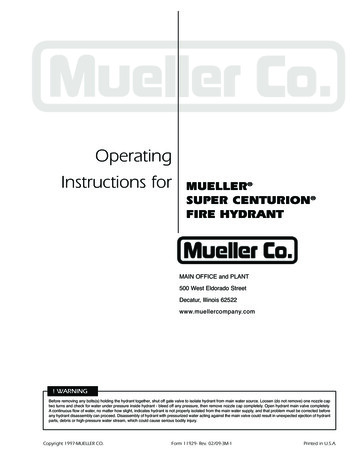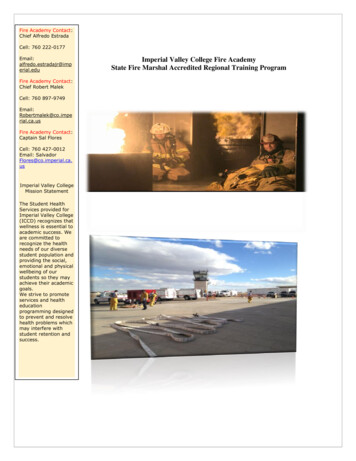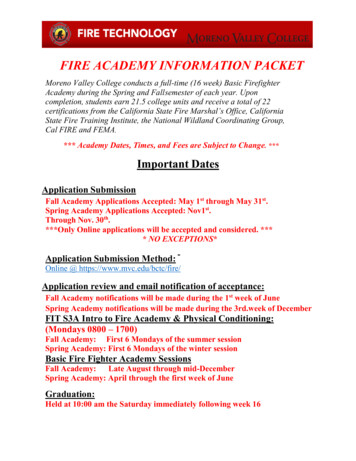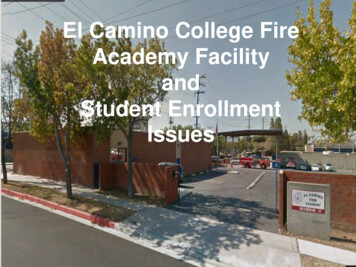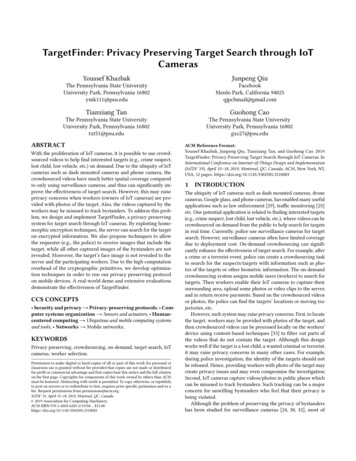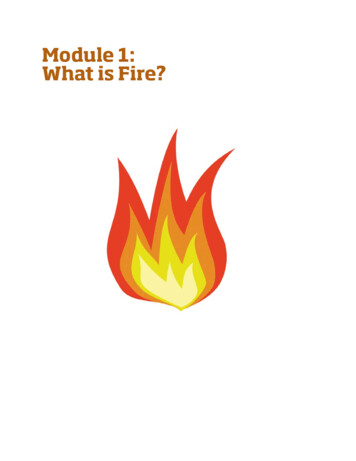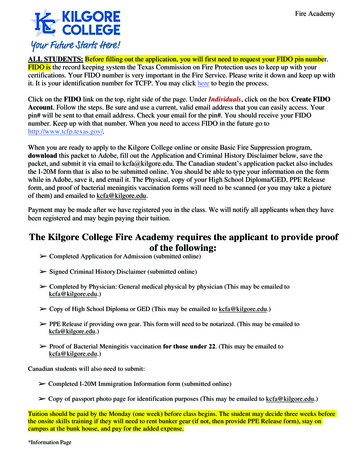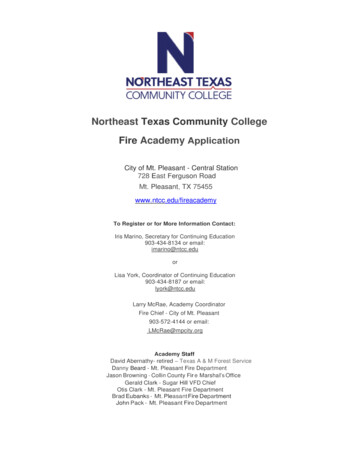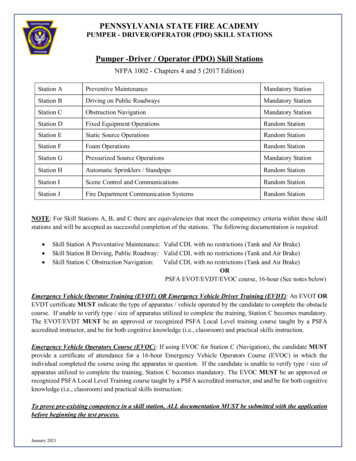
Transcription
PENNSYLVANIA STATE FIRE ACADEMYPUMPER - DRIVER/OPERATOR (PDO) SKILL STATIONSPumper -Driver / Operator (PDO) Skill StationsNFPA 1002 - Chapters 4 and 5 (2017 Edition)Station APreventive MaintenanceMandatory StationStation BDriving on Public RoadwaysMandatory StationStation CObstruction NavigationMandatory StationStation DFixed Equipment OperationsRandom StationStation EStatic Source OperationsRandom StationStation FFoam OperationsRandom StationStation GPressurized Source OperationsMandatory StationStation HAutomatic Sprinklers / StandpipeRandom StationStation IScene Control and CommunicationsRandom StationStation JFire Department Communication SystemsRandom StationNOTE: For Skill Stations A, B, and C there are equivalencies that meet the competency criteria within these skillstations and will be accepted as successful completion of the stations. The following documentation is required: Skill Station A Preventative Maintenance: Valid CDL with no restrictions (Tank and Air Brake)Skill Station B Driving, Public Roadway: Valid CDL with no restrictions (Tank and Air Brake)Skill Station C Obstruction Navigation: Valid CDL with no restrictions (Tank and Air Brake)ORPSFA EVOT/EVDT/EVOC course, 16-hour (See notes below)Emergency Vehicle Operator Training (EVOT) OR Emergency Vehicle Driver Training (EVDT): An EVOT OREVDT certificate MUST indicate the type of apparatus / vehicle operated by the candidate to complete the obstaclecourse. If unable to verify type / size of apparatus utilized to complete the training, Station C becomes mandatory.The EVOT/EVDT MUST be an approved or recognized PSFA Local Level training course taught by a PSFAaccredited instructor, and be for both cognitive knowledge (i.e., classroom) and practical skills instruction.Emergency Vehicle Operators Course (EVOC): If using EVOC for Station C (Navigation), the candidate MUSTprovide a certificate of attendance for a 16-hour Emergency Vehicle Operators Course (EVOC) in which theindividual completed the course using the apparatus in question. If the candidate is unable to verify type / size ofapparatus utilized to complete the training, Station C becomes mandatory. The EVOC MUST be an approved orrecognized PSFA Local Level Training course taught by a PSFA accredited instructor, and and be for both cognitiveknowledge (i.e., classroom) and practical skills instruction.To prove pre-existing competency in a skill station, ALL documentation MUST be submitted with the applicationbefore beginning the test process.January 2021
PENNSYLVANIA STATE FIRE ACADEMYPUMPER - DRIVER/OPERATOR (PDO) SKILL STATIONSSTATION A – Preventive MaintenanceTest SiteTest DateReference NFPA 1002 (2017 Edition), Chapters 4 & 5Mandatory Station: JPRs 4.2.1, 4.2.2, 5.1.2Candidate #Check the Test TypeInitialRetestEvaluator Notes: If a task (i.e. foam system) is not applicable, please mark n/a and provide a comment, then calculatePASS on all remaining tasks. Also, candidates MUST conduct the air brake checks: pressure leakage (brake appliedand not applied); low air warning; spring-brake activation; air pressure build; lug test; and service check.Directions: Using appropriate PPE and given the manufacturer’s specifications, and local procedures, perform visualand operational checks on the systems and components of a fire department apparatus, and service and correct (as able)any deficiencies found so that the operational status of the apparatus is verified. Do you have any questions?Performance Outcome: Pass / Fail is determined by 18 of 18 tasks being correctly Checks battery(s) for condition, connections, charging, and fluidChecks braking system for damage, leaks, and all checks noted in the evaluator notesChecks coolant system for leaks, hose conditions, and system integrityChecks vehicle electrical system, including functionally of all componentsChecks fuel system integrityChecks hydraulic fluids and system integrity (if applicable)Checks oil and other fluids for capacity and system integrityChecks tire thread depth, thread wear, condition, and pressureChecks steering system for smooth operation, fluid levels, excessive free play and integrityChecks belts for wear, tension, and conditionChecks that all tools, appliances and equipment are securely mountedChecks built-in safety features (if applicable)Performs a visual & operational check on the water tank & other extinguishing agentsPerforms visual and operational check on the pump systemPerforms a visual and operational check on the foam system (if applicable)Recognizes a system problem(s) and document on departmental forms the visual andoperational checks and reports any deficiencies according to policiesUtilizes hand tools to correct any noted problem in accord with department policy(if applicable)Completes all tasks without compromising personal safetyPlease indicate skill outcome PASS FAILEvaluator Comments:Evaluator Signature:January 2021Evaluator #
PENNSYLVANIA STATE FIRE ACADEMYPUMPER - DRIVER/OPERATOR (PDO) SKILL STATIONSSTATION B – Driving on Public RoadwaysTest SiteTest DateReference NFPA 1002 (2017 Edition), Chapter 4Mandatory Station JPR 4.3.1Candidate #Check the Test TypeInitialRetestDirections: Operate a fire department vehicle, given a vehicle and a predetermined route on a public roadway thatincorporates the maneuvers and features as specified in the following tasks which a driver/operator is expected toencounter during normal operations, so that the vehicle is safely operated in compliance with all applicable state andlocal laws and departmental rules and regulations. Do you have any questions?Performance Outcome: Pass / Fail is determined by 15 of 15 tasks being correctly performed.No.123456789101112131415TasksUtilizes passenger restraint systems as appropriateAdjusts mirrors, seat height and steering wheel as appropriateScans dashboard instruments routinely and can provide instrument informationNegotiates four left and four right turnsNegotiates a straight section of urban business street or two-lane rural road of at least 1 mile(1.6 km) in lengthNegotiates one through-intersection and two intersections where a stop must be madeNegotiates one railroad crossingNegotiates one curve (either left or right)Negotiates a section of limited-access highway which includes a conventional ramp entranceand exit, and a section of road long enough to allow two lane changes.Negotiates a downgrade steep and long enough to require down-shifting and brakingNegotiates an upgrade steep and long enough to require gear change to maintain speedNegotiates one underpass or a low clearance bridgeMaintain safe following distance with other vehicles throughout the tripIdentifies the height, weight, and length of the apparatusCompletes all tasks without compromising personal safetyYesNoPlease indicate skill outcome PASS FAILEvaluator Comments:Evaluator Signature:January 2021Evaluator #
PENNSYLVANIA STATE FIRE ACADEMYPUMPER - DRIVER/OPERATOR (PDO) SKILL STATIONSSTATION C – Obstruction NavigationTest SiteTest DateReference NFPA 1002 (2017 Edition), Chapter 4Mandatory Station JPRs 4.3.2, 4.3.3, 4.3.4, 4.3.5, 4.3.6Candidate #Check the Test TypeInitialRetestDirections: Operate a fire department vehicle, given a vehicle and a predetermined route on a public roadway whichincorporates the maneuvers and features specified in the following tasks which a driver/operator is expected to encounterduring normal operations, so that the vehicle is safely operated in compliance with all applicable state and local lawsand departmental rules and regulations. Do you have any questions?Performance Outcome: Pass / Fail is determined by 6 of 6 tasks being correctly performed.No.123456TasksBack a vehicle from a roadway into a restricted space from both the right and left sides ofthe vehicle, given a fire department vehicle, a spotter, and restricted spaces 12ft (3.66 m) inwidth, requiring 90-degree right-hand and left-hand turns from the roadway, so that thevehicle is parked within the restricted area without having to stop and pull forward andwithout striking obstructions.Operate the vehicle around roadway obstructions while moving forward and in reverse,given a fire department vehicle, a spotter for backing, and a roadway with obstructions, sothat the vehicle is maneuvered through the obstructions without stopping to change directionof travel and without striking obstructions.Turn a fire department vehicle 180 degrees within a confined space, given a fire departmentvehicle, a spotter for backing, and an area in which the vehicle cannot perform a U-turnwithout stopping and backing up, so that the vehicle is turned 180 degrees without strikingobstructions within the confined space.Maneuver a fire department vehicle in areas with restricted horizontal and verticalclearances, given a fire department vehicle and a course requiring the operator to movethrough areas with restricted horizontal and vertical clearances, so that the operatoraccurately judges the ability of the vehicle to pass through the openings and that noobstructions are hit.Operate a fire department vehicle using defensive driving techniques under emergencyconditions so that vehicle control is maintained.Demonstrates ability to utilize mirrors while operating the apparatusYesNoPlease indicate skill outcome PASS FAILEvaluator Comments:Evaluator Signature:January 2021Evaluator #
PENNSYLVANIA STATE FIRE ACADEMYPUMPER - DRIVER/OPERATOR (PDO) SKILL STATIONSReference NFPA 1002 (2017 Edition), Chapter 4Random Station: JPR 4.3.7STATION D – Fixed Equipment OperationsTest SiteTest DateCandidate #Check the Test TypeInitialRetestDirections: Given system and equipment, manufacturer’s specifications and instructions, and departmental policies andprocedures, operate in accordance with applicable instructions and policies all fixed systems and equipment on theapparatus not specifically addressed elsewhere in this standard. Types of equipment and systems include but are notlimited to: electric generation equipment, lighting systems, air compressors, air cascade systems, hydraulic rescue toolsystems, power reels for air or hydraulic hoses, cranes and stabilizers, and A-frames or other lifting equipment. Otherequipment may include such items as portable pumps, exhaust fans, saws and cord reels. Do you have any questions?Performance Outcome: Pass / Fail is determined by 5 of 5 tasks being correctly performed.No.List Equipment Operated:TasksYesNo12345Completes all tasks without compromising personal safetyPlease indicate skill outcomePASSFAILEvaluator Comments:Evaluator Signature:January 2021Evaluator #
PENNSYLVANIA STATE FIRE ACADEMYPUMPER - DRIVER/OPERATOR (PDO) SKILL STATIONSSTATION E – Static Source OperationsTest SiteTest DateReference NFPA 1002 (2017 Edition), Chapter 5Random Station: JPRs 5.2.3, 5.2.4 (3)Candidate #Check the Test TypeInitialRetestEvaluator Note: For Task 11, please indicate the type of pressure control device used.Directions: Given a static water source, produce an effective hand-line or master stream(s) so that the pump is safelyengaged, all pressure control and vehicle safety devices are set, the rated flow of the nozzle(s) is achieved andmaintained, and the apparatus is continuously monitored for potential problems. Do you have any questions?Performance Outcome: Pass / Fail will be determined by 12 of 12 tasks being correctly performed.No.12345678910TasksSelects proper suction hose / hoses (size, lengths)Selects proper strainer equipmentMakes necessary hose / appliance connectionsIdentifies pumper suction connectionConnects assembled hose / strainer to pumper suction portPlaces strainer in water and properly secures the sameEngages the pumpEstablishes a draftCharges appropriate hand line(s) or master streamAdjusts pressure to obtain correct flow(s)11Sets pressure control device: Manual12Completes all tasks without compromising personal safetyYesNoAutomaticPlease indicate skill outcome PASS FAILEvaluator Comments:Evaluator Signature:January 2021Evaluator #
PENNSYLVANIA STATE FIRE ACADEMYPUMPER - DRIVER/OPERATOR (PDO) SKILL STATIONSSTATION F – Foam OperationsTest SiteTest DateReference NFPA 1002 (2017 Edition), Chapter 5Random Station: JPR 5.2.6Candidate #Check the Test TypeInitialRetestEvaluator Note: For Task 1 on checklist below, please check the type of system and foam used.Directions: Given an apparatus onboard water tank, produce an effective hand-line stream(s) so that the pump is safelyengaged, all pressure control and vehicle safety devices are set, the rated flow of the nozzle(s) is achieved andmaintained, and the apparatus is continuously monitored for potential problems. Do you have any questions?Performance Outcome: Pass / Fail is determined by 4 of 4 tasks being correctly performed.No.1TasksEstablishes a foam stream with available equipment:YesFoam SystemClass A or B FoamPortable EducatorClass AOn-BoardClass A (CAFS)NoClass B234Establishes the proper engine pressure for equipment providedEstablishes a properly proportioned foam stream(s)Completes all tasks without compromising personal safetyPlease indicate skill outcome PASS FAILEvaluator Comments:Evaluator Signature:January 2021Evaluator #
PENNSYLVANIA STATE FIRE ACADEMYPUMPER - DRIVER/OPERATOR (PDO) SKILL STATIONSSTATION G – Pressurized Water Source OperationsTest SiteTest DateReference NFPA 1002 (2017 Edition), Chapter 5Mandatory Station: JPRs 4.4.1, 5.2.4 (1, 2, 4), 5.2.3, 5.2.5Candidate #Check the Test TypeInitialRetestEvaluator Note: For Task 4 below, please indicate the type of pressure control device used.Directions: Given a pressurized water source, safely engage the pump and maintain a given flow during a relay pumpingoperation. Establish a water supply using on-board water, set all pressure control and vehicle safety devices, andmaintain the rated flow for a given relay configuration. Once established, connect to a hydrant, transfer the water supplyfrom on-board to the external source, maintain the flow, monitor the operations for problems, notify the relay engine ofsupply status, refill the on-board tank, and shut down the water supply when directed. Do you have any questions?Performance Outcome: Pass / Fail is determined by 13 of 13 tasks being correctly performed.No.Tasks1 Make appropriate connections to supply an additional engine2 Engages pump and establishes water supply using on-board/tank water3 Adjusts pressure to obtain correct flow4Sets pressure control device: Manual5Hand lays supply line and a makes hydrant-to-pumper connection678Opens hydrant fully and charges the lineMakes the transition from an internal to external water sourceEnsures the on-board water tank is refilledUsing the pressurized source, assures the relay to supply an additional engine is maintainedwith correct flow and pressureNotifies relay engine via department communications equipment of water supply shutdownShuts down the relay supply and disconnects the supply lineShuts down the hydrant feed and disconnects the from hydrantCompletes all tasks without compromising personal safety910111213YesNoAutomaticPlease indicate skill outcome PASS FAILEvaluator Comments:Evaluator Signature:January 2021Evaluator #
PENNSYLVANIA STATE FIRE ACADEMYPUMPER - DRIVER/OPERATOR (PDO) SKILL STATIONSSTATION H – Automatic Sprinkler /Standpipe OperationsTest SiteTest DateReference NFPA 1002 (2017 Edition), Chapter 5Random Station JPR 5.2.7Candidate #Check the Test TypeInitialRetestEvaluator Note: a) Task 4 is based on the specific scenario information provided by the test site.b) Task 5 on the checklist below, please indicate the type of device used.Directions: Given a water source and specific system information, supply water to a fire sprinkler / standpipe systemso that water is supplied to the system at the correct volume and pressure for a specified configuration, the pump issafely engaged, all pressure control and vehicle safety devices are set, and the apparatus is continuously monitoredfor potential problems. Do you have any questions?Performance Outcome: Pass / Fail is determined by 6 of 6 tasks being correctly performed.No.123456TasksMake appropriate connections to supply a standpipe / sprinkler systemEngages pumpEstablishes a water flowAdjusts pressure to obtain correct volume (based on scenario information)Sets pressure control device: ManualAutomaticCompletes all tasks without compromising personal safetyYesNoPlease indicate skill outcome PASS FAILEvaluator Comments:Evaluator Signature:January 2021Evaluator #
PENNSYLVANIA STATE FIRE ACADEMYPUMPER - DRIVER/OPERATOR (PDO) SKILL STATIONSSTATION I – Scene Control and CommunicationsTest SiteTest DateReference NFPA 1002 (2017 Edition), Chapters 4 & 5Random Station JPRs 4.4.3, 4.4.4, 4.4.1, 5.2.1, 5.2.2Candidate #Check the Test TypeInitialRetestEvaluator Note: As the incident commander and using a radio communications system, provide a traffic controlassignment and an order to initiate an emergency procedure (e.g., clear working scene due to oncoming un-attentivetraffic).Directions: Given PPE and an equipped fire apparatus, properly don your PPE, board the apparatus and prepare yourselffor travel. Upon command from the evaluator, dismount the apparatus and complete the following assignments: placewarning / scene control devices and establish a traffic / safe work zone; demonstrate the ability to use fire departmentcommunications systems, and be prepared to initiate an emergency procedure to clear the work zone. Do you have anyquestions?Performance Outcome: Pass / Fail is determined by 8 of 10 tasks being correctly performed.No.Tasks1 Wears all required protective clothing for the given traffic scenarioReceives and confirms work zone / traffic control assignment via radio communications2from the incident command3 Uses handrails / secures good footing while dismounting4 Places warning devices appropriately (i.e., 100 – 1,500 feet up stream from traffic)5 Identifies the work zone downstream of trafficEstablishes a one lane taper zone (75 – 100 feet) from apparatus using appropriate6equipmentReceives and confirms via radio and initiates per SOP an emergency procedure / evacuation7signal based on the order from incident command to clear the work zone8 Disassembles work zone9 Always faces approaching traffic when picking up the traffic control devices10 Completes all tasks without compromising personal safetyYesNoPlease indicate skill outcome PASS FAILEvaluator Comments:Evaluator Signature:January 2021Evaluator #
PENNSYLVANIA STATE FIRE ACADEMYPUMPER - DRIVER/OPERATOR (PDO) SKILL STATIONSSTATION J – Fire Dept. Communication SystemsTest SiteTest DateReference NFPA 1002 (2017 Edition) Chapter 4Random Station JPRs 4.4.2, 4.4.1Candidate #Check the Test TypeInitialRetestDirections: Given a fire department phone and/or an intercom system and a procedure, answer the telephone or operatethe intercom system so that a message is appropriately relayed. Do you have any questions?Performance Outcome: Pass / Fail is determined by 6 of 8 tasks being correctly performed.No.567TasksOperates fire department telephone or intercom system correctly and follows departmentprocedures for answering a non-emergency callListens actively to the caller and records the message correctlyInteracted with caller appropriately and courteously (greeting, tone of voice, and closing)Identifies appropriate distribution method and properly distribute information in a timelymanner (handwritten or electronic message, specific place to post message)Follows departmental SOPs for taking and receiving alarms, radio codes, or proceduresAware of procedures for reporting an emergencyAware of information needs of dispatch center8Completes tasks appropriately and in a professional manner1234YesNoPlease circle final skill outcome PASS FAILEvaluator Comments:Evaluator Signature:January 2021Evaluator #
PENNSYLVANIA STATE FIRE ACADEMY . PUMPER - DRIVER/OPERATOR (PDO) SKILL STATIONS . January 20 21 . Evaluator Notes: If a task (i.e. foam system) is not applicable, please mark n/a and provide a comment, then calculate PASS on all remaining tasks. Also, candidates MUST conduct the air brake checks: pressure leakage (brake applied and not applied); low air warning; spring-brake activation; air .
